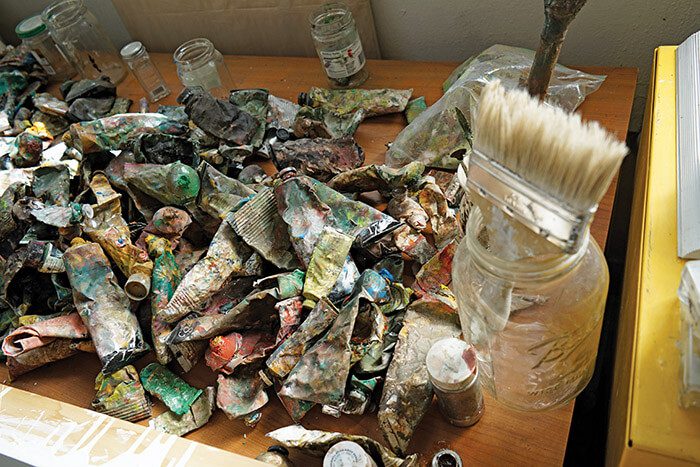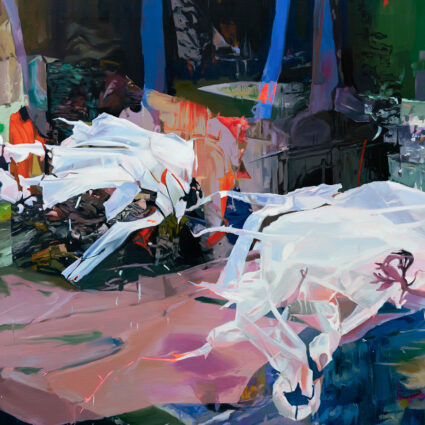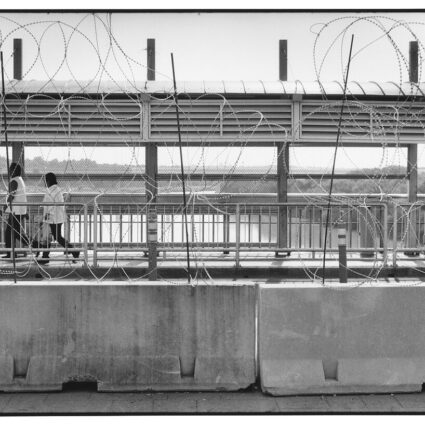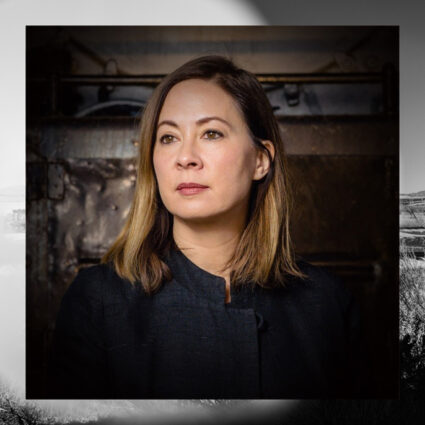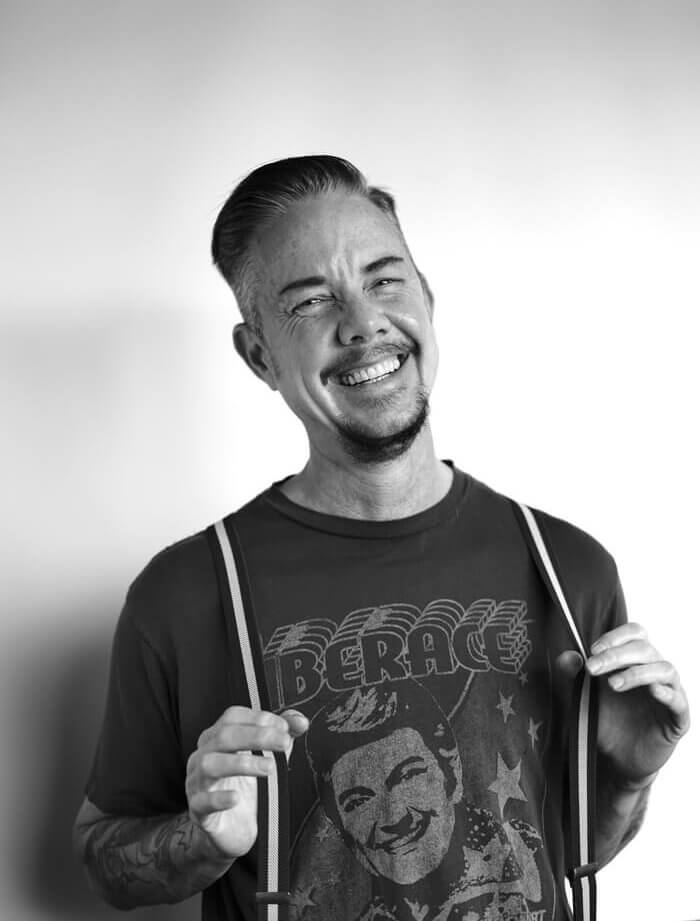
Earl McBride works across a variety of moods, methods, and vibrations—predominantly in the realm of abstract painting. Throughout, his layered markmaking against clean white or softly patinaed panels creates compositions that buzz with tension. In more vigorous pieces, pigment and line are suspended, about to collide in a frenzy. More reserved are gestural vignettes in which a few colorful beats punctuate a spacious white backdrop.
A third-year graduate student in Painting and Drawing at the University of New Mexico, Albuquerque, McBride is nearing graduation in May 2017. The body of work the artist has been cultivating over the last few years will be on view in a solo show opening April 22 at Richard Levy Gallery in Albuquerque. The artist chatted with us about the grad school experience and coming into one’s own as a painter:
Clayton Porter: Why are you in New Mexico?
Earl McBride: I started coming to New Mexico maybe twenty years ago to see my buddy who lived here, and I was living in L.A. When I came here, I could breathe, and I was energized. I would go back to L.A. and I would feel the compression of the city. So maybe thirteen years ago I moved here for my health.
CP: What’s kept you here?
EM: Maybe the main reason is the sky—and cheap studio space! The airport is easy, I can get to L.A. and New York from here. And it’s easy to live here. I’m energized by New Mexico. It’s big; I feel like I can be as big as I want to be here. It’s expansive, and it allows me to feel expansive.
CP: What are your studio hours?
EM: I don’t have a regular schedule, but I am here almost all the time. I sleep late, so I come in around ten or eleven. And then I’ll do other things—I’ll leave for a while, come back—and then I’ll leave maybe around midnight. I’m here a lot. This is my favorite place.
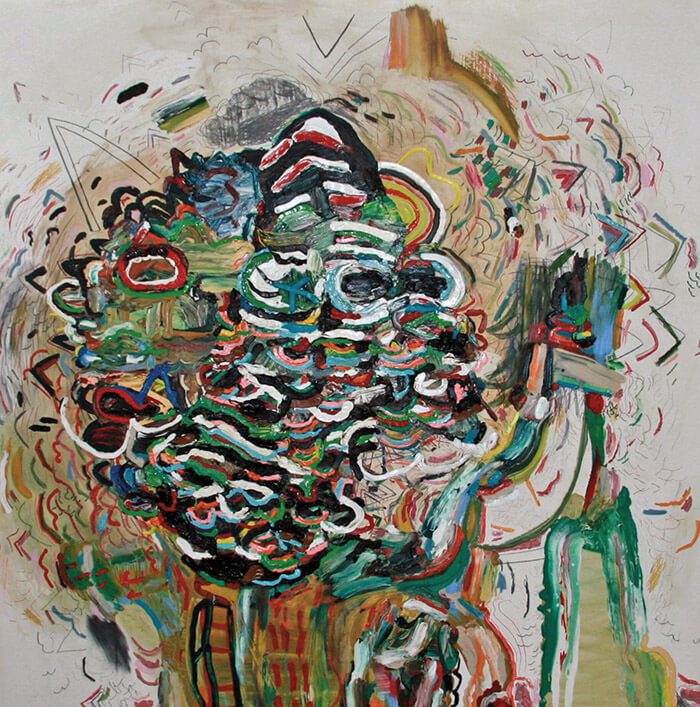
Lauren Tresp: What was your decision in going to grad school?
EM: I was working in a gallery in Santa Fe, for people I loved, and I enjoyed the work, but it was really hard to maintain a studio practice. I was working in my garage, and it was dark. I’d work at least twenty hours at the gallery and expend creative energy, then go into the studio. It was challenging. When I would get up and work in the studio and then have to go to work, it felt like fracturing. It was hard to rip myself out of the studio. I’d always wanted to go to grad school, so when I approached my fiftieth birthday, I made a decision to apply. I wanted three years to devote to my work and to try to get a gallery. Everything’s worked out, so it was a great decision, and I’ve grown a lot here in this studio. I needed this studio.
I feel like recently I’ve gained access to all parts of myself, and I feel that the paintings are a way for me to actualize all of myself. I’m really excited about each painting, and I’m really excited about my next paintings.
CP: What’s going to happen to your studio situation after you graduate?
EM: I’d like to do some residencies, and I’d like to do a body of work somewhere without the influences of my own studio. I would be somewhere quiet and make work that’s mindful and about that moment. So I’m looking forward to applying to some residencies. Getting a studio here in Albuquerque—I was going to work at my house, but I don’t want to move back into my garage. I think it’ll be really nice to go somewhere and work. I like the discipline of that: getting up and getting dressed and coming to work. Then hopefully, eventually, I’ll get a gallery in L.A. or New York and get into that conversation. But I just want to make as much work as I can, good work.
It looks like chaos most of the time, but I’m really going for balance—something that is complete and lands in a way that feels whole.
LT: Do you sketch before painting?
EM: No, I don’t like to plan; I don’t like to know what I’m doing. I want each piece to be its own thing and a completely new experience for me. It’s kind of a selfish act. I’m entertaining [myself], so I want to be surprised. This piece is called Chicken and Waffles, and there’s a whole chicken right here. And that was a surprise. [Laughs.] And this piece is simpler. I’m usually going for something like this, but I’m rarely able to achieve it. I tend to like something that is more poetry and less experiential.
LT: How do you know when you’re done?
EM: [Groans.]
LT: Is that a stupid question?
EM: I don’t know.
CP: I don’t think it is, but it’s tough.
EM: It’s really hard. Answering it makes you a better painter if you answer with a painting. Like this piece: this is quick, without too many moves. It’s not done; it needs white here to even it out. There’s a balance I’m going for, believe it or not. It looks like chaos most of the time, but I’m really going for balance—something that is complete and lands in a way that feels whole. When I’m looking at it, and it’s not finished, I feel anxious and upset, and so I do something to make that [feeling] go away. That makes it done. Every piece is okay on its own; it doesn’t need anything else.
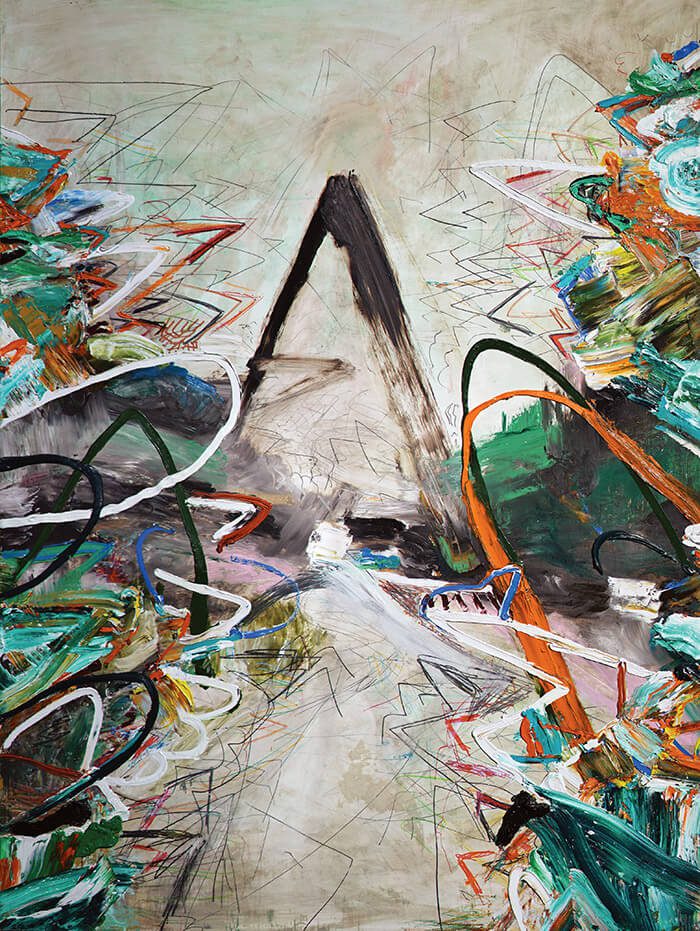
CP: Are you looking forward to graduating?
EM: Yes and no. I’m enjoying this time—but I am ready. I thought I would want to stay. I thought I wouldn’t want to leave this studio, ever. But I’m very excited about leaving and finding another space and getting up every day and going to the studio, doing my thing. I’m enjoying my time here, but I’m ready.
CP: Moving forward out of grad school, are you going to try to abstain from getting another part-time job?
EM: Yes. I’m going to try. I hope I sell a couple of things in the show in the spring, and then, whatever I make, I’d like to rent a studio and go for it, see what happens. I feel like I can do it. I really, really do. Before I came here, I didn’t think so. I thought I’d always have to work another job, but now I like to think that I don’t have to. I’m just gonna try it, and we’ll see what happens. If I fail, I fail, and that’s what that is.
There’s a viscosity to paint; there’s a sexiness to paint; there’s an oiliness to paint. It’s kind of decadent. It’s expensive. I use it in an excessive way.
LT: Why paint? And have you worked in other media?
EM: I have. I went to Otis, and when I was at Otis, I made a lot of video, a lot of installation, a lot of sculpture, and I painted in secret. Paint always did something that nothing else can do. It feels natural for me to express myself that way. I’ve been painting since I was little. I had an aunt that taught me to paint when I was tiny. She was a painter. When I was little I stuttered, so there was a period where I didn’t talk a lot. I wrote stories and I drew and painted. It became a language, an integral part of my language and how I communicate, so I need it. Words fail me. I try, but most of the time they fail me. But painting doesn’t. It holds something that words can’t contain.
There’s a viscosity to paint; there’s a sexiness to paint; there’s an oiliness to paint. It’s kind of decadent. It’s expensive. I use it in an excessive way. There’s a riskiness sometimes to the way I combine things with paint that I enjoy. I enjoy the challenge of that. I’m also in a conversation with other painters. I want to be in a conversation with them, so I’m using that way of communicating, so we can talk.
LT: What has been the biggest outcome from working with the professors or other students here?
EM: I have a stellar committee, six people, and they each offer something. Scott Anderson is here, and he’s one of my favorite painters in the world. He’s one of the reasons I came here, and his paintings are inspirational. Our conversations about painting are inspirational. Bart Exposito is my chair, and he’s a man that I knew from L.A. and just a terrific person and a solid painter. Raychael Stine is on my committee, and her paintings are fantastic. And Patrick Manning: we have great conversations about art and literature. Everybody gives me something. Grad school has been. . . a time for me to step into myself. I feel like I was holding myself back for a lot of years, not allowing myself to live fully or for my work to be what it should be. It was all inside, and I wasn’t letting that come out. The other objective for coming to grad school was to become more me and let the paintings become what they needed to be—I feel like that has happened.
